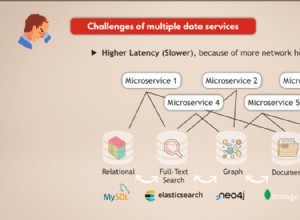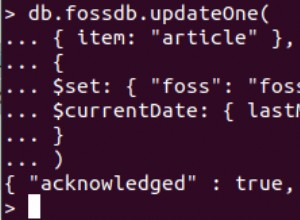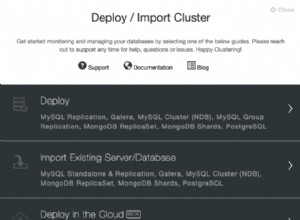Jeśli chcesz czysto poza procesem, to jest całkiem proste — coś takiego jak poniżej, ale zwróć uwagę, że BookSleeve jest przeznaczony do udostępniania :jest w pełni bezpieczny wątkowo i działa jako multiplekser - nie należy ich tworzyć / usuwać dla każdego wywołania. Zauważ też, że w tym kontekście zakładam, że będziesz obsługiwać serializację osobno, więc po prostu wystawiam byte[] API:
class MyCache : IDisposable
{
public void Dispose()
{
var tmp = conn;
conn = null;
if (tmp != null)
{
tmp.Close(true);
tmp.Dispose();
}
}
private RedisConnection conn;
private readonly int db;
public MyCache(string configuration = "127.0.0.1:6379", int db = 0)
{
conn = ConnectionUtils.Connect(configuration);
this.db = db;
if (conn == null) throw new ArgumentException("It was not possible to connect to redis", "configuration");
}
public byte[] Get(string key)
{
return conn.Wait(conn.Strings.Get(db, key));
}
public void Set(string key, byte[] value, int timeoutSeconds = 60)
{
conn.Strings.Set(db, key, value, timeoutSeconds);
}
}
Co staje się interesujące jest, jeśli chcesz mieć dwupoziomową pamięć podręczną - tj. używając pamięci lokalnej i pamięć podręczna poza procesem, ponieważ teraz potrzebujesz unieważnienia pamięci podręcznej. Pub/sub sprawia, że jest to przydatne — pokazuje to poniżej. Może to nie być oczywiste, ale oznaczałoby to wykonanie znacznie mniejszej liczby wywołań redis (możesz użyć monitor aby to zobaczyć) - ponieważ większość żądań jest obsługiwana z lokalnej pamięci podręcznej.
using BookSleeve;
using System;
using System.Runtime.Caching;
using System.Text;
using System.Threading;
class MyCache : IDisposable
{
public void Dispose()
{
var tmp0 = conn;
conn = null;
if (tmp0 != null)
{
tmp0.Close(true);
tmp0.Dispose();
}
var tmp1 = localCache;
localCache = null;
if (tmp1 != null)
tmp1.Dispose();
var tmp2 = sub;
sub = null;
if (tmp2 != null)
{
tmp2.Close(true);
tmp2.Dispose();
}
}
private RedisSubscriberConnection sub;
private RedisConnection conn;
private readonly int db;
private MemoryCache localCache;
private readonly string cacheInvalidationChannel;
public MyCache(string configuration = "127.0.0.1:6379", int db = 0)
{
conn = ConnectionUtils.Connect(configuration);
this.db = db;
localCache = new MemoryCache("local:" + db.ToString());
if (conn == null) throw new ArgumentException("It was not possible to connect to redis", "configuration");
sub = conn.GetOpenSubscriberChannel();
cacheInvalidationChannel = db.ToString() + ":inval"; // note that pub/sub is server-wide; use
// a channel per DB here
sub.Subscribe(cacheInvalidationChannel, Invalidate);
}
private void Invalidate(string channel, byte[] payload)
{
string key = Encoding.UTF8.GetString(payload);
var tmp = localCache;
if (tmp != null) tmp.Remove(key);
}
private static readonly object nix = new object();
public byte[] Get(string key)
{
// try local, noting the "nix" sentinel value
object found = localCache[key];
if (found != null)
{
return found == nix ? null : (byte[])found;
}
// fetch and store locally
byte[] blob = conn.Wait(conn.Strings.Get(db, key));
localCache[key] = blob ?? nix;
return blob;
}
public void Set(string key, byte[] value, int timeoutSeconds = 60, bool broadcastInvalidation = true)
{
localCache[key] = value;
conn.Strings.Set(db, key, value, timeoutSeconds);
if (broadcastInvalidation)
conn.Publish(cacheInvalidationChannel, key);
}
}
static class Program
{
static void ShowResult(MyCache cache0, MyCache cache1, string key, string caption)
{
Console.WriteLine(caption);
byte[] blob0 = cache0.Get(key), blob1 = cache1.Get(key);
Console.WriteLine("{0} vs {1}",
blob0 == null ? "(null)" : Encoding.UTF8.GetString(blob0),
blob1 == null ? "(null)" : Encoding.UTF8.GetString(blob1)
);
}
public static void Main()
{
MyCache cache0 = new MyCache(), cache1 = new MyCache();
string someRandomKey = "key" + new Random().Next().ToString();
ShowResult(cache0, cache1, someRandomKey, "Initially");
cache0.Set(someRandomKey, Encoding.UTF8.GetBytes("hello"));
Thread.Sleep(10); // the pub/sub is fast, but not *instant*
ShowResult(cache0, cache1, someRandomKey, "Write to 0");
cache1.Set(someRandomKey, Encoding.UTF8.GetBytes("world"));
Thread.Sleep(10); // the pub/sub is fast, but not *instant*
ShowResult(cache0, cache1, someRandomKey, "Write to 1");
}
}
Zwróć uwagę, że w pełnej implementacji prawdopodobnie chcesz obsługiwać sporadyczne zerwane połączenia, z nieco opóźnionym ponownym połączeniem itp.




